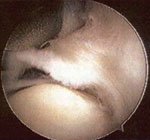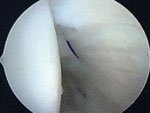Concomitant SLAP, infraspinatus tears offer poor prognosis for return to play in overhead athletes
SAN FRANCISCO — Although overhead throwing athletes with isolated SLAP tears typically have encouraging prognoses for returning to previous playing levels, a recently presented study shows that those with concomitant SLAP and infraspinatus tears are less likely to experience similar success.
Jonathan P. Van Kleunen, MD, presented his team’s findings at the 2011 Annual Meeting of the Arthroscopy Association of North America.
Retrospective review
Van Kleunen and colleagues performed a retrospective review of 20 overhead, high-level athletes younger than 25 years of age who underwent simultaneous arthroscopic repairs of both a significant (greater than 50% tendon thickness) tear of the infraspinatus tendon using suture and a SLAP tear using a standard suture anchor technique between 2005 and 2008.
The investigators reviewed postoperative records to determine the patients’ ability to return to play, as well as their postoperative level of performance. According to the study abstract, the patients were also contacted to determine their levels of postoperative sports participation.
Return rate
All 20 patients in the study attempted to return to sports after they completed postoperative rehabilitation. The investigators discovered that five patients returned to similar pre-injury levels of play or better. Among the remaining 15 patients, six returned to a lower level of play. These patients were able to play the same position or switched to another position due to a decline in throwing velocity, the abstract noted. Nine of the 20 patients were unable to return to play. There were no reported complications or reoperations.
|
|
|
Images: Van Kleunen JP |
Van Kleunen’s team concluded through their study that significant tears of the infraspinatus in combination with glenohumeral internal rotation deficit (GIRD) and SLAP tears caused a significant worsening of the prognosis for same-level return to play in overhead throwing athletes.
“Concomitant SLAP and infraspinatus tear in an overhead athlete carries a more guarded prognosis for a return to pre-injury level of play,” Van Kleunen concluded. “Our 25% return rate to a pre-injury level is lower than what has been in the literature. We feel that partial infraspinatus tears greater than 50% of the tendon thickness have a worse prognosis than smaller tears, and these patients are less likely to return to a pre-injury level of play than those with less complex injuries.” – by Robert Press
Reference:
- Van Kleunen JP, Field LD, Savoie FH. Return to high level throwing after combination infraspinatus repair, SLAP repair, and release of glenohumeral internal rotation deficit. Paper SS-08. Presented at the 2011 Annual Meeting of the Arthroscopy Association of North America. April 14-16. San Francisco.
- Jonathan P. Van Kleunen, MD, can be reached at Mississippi Sports Medicine and Orthopaedic Center, 1325 E. Fortification St, Jackson, MS 39202; email: vankleun@gmail.com.
- Disclosure: Van Kleunen has no relevant financial disclosures.
Be realistic when counseling throwing athletes about returning to the same level of play after rotator cuff repair. High-level throwing athletes with the combination of a SLAP repair, side-to-side infraspinatus repair and glenohumeral internal rotation deficit rarely return to throwing at the elite level.
Accomplished surgeons Van Kleunen, Field and Savoie had only 25% of their patients return to the same level of throwing. Half did not return to throwing at all.
A side-side-side PDS suture repair was used for repair. A tendon-to-bone repair would create a nonanatomical high tension cuff repair. This articular side deep layer of the supraspinatus tendon has poor healing powers. The mechanics of throwing at a high level leading to this tear may not have change despite a specialized rehabilitation program.
— James C. Esch, MD
Orthopedics
Today Editorial Board member
Orthopaedic Surgeons of North County
Oceanside, Calif.
Disclosure: He has no relevant financial
disclosures.



